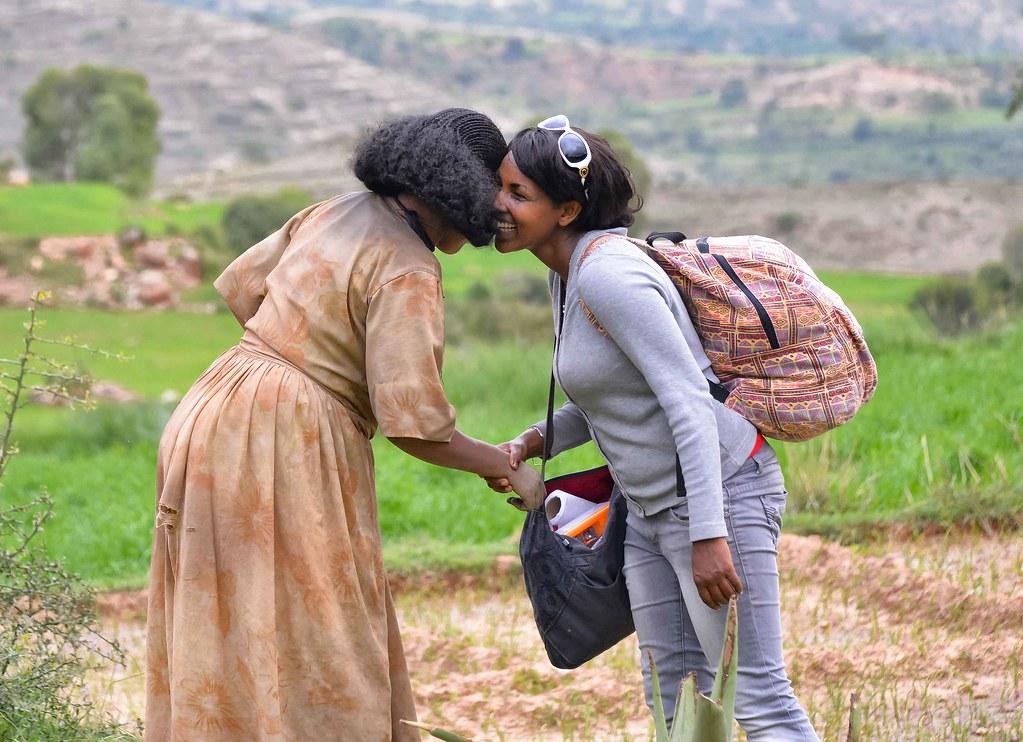2 Capítulo 1: Sección 1: Los saludos y las despedidas
Section Goal
In this section, students will learn how to greet and say goodbye to another person.

¡A leer!
Actividad 3. Encantado
Instructions: Read the following text about greetings in Spanish-speaking countries and decide if the following statements are true (C) or false (F).

When you are introducing yourself—or even when you are introducing one person to another person—there are some standard phrases that you typically use. First, you usually give your name or the name of the person you are introducing. Then, you usually indicate in some way that you are pleased to meet the other person.
With greetings and goodbyes in Spanish, the conversation will vary somewhat depending upon the relationship you have or will have with the person you are meeting. This relationship ranges from being very familiar to very formal. For example, if you are introducing yourself to someone your own age or with whom you would be considered a peer, to children, or to friends of friends, you would likely use a more informal greeting. If you are greeting someone with more of a social distance, such as an authority figure (professor, doctor, boss, an elder, or a potential employer), you would use a more formal greeting.
As you learn the phrases for introductions and goodbyes, you might find that there are words or grammatical points you don’t understand. Don’t worry that you don’t know why ¿Cómo se llama? and ¿Cómo te llamas? are different—for the time being, just focus on learning the phrases and patterns.[1]
Questions: Cierto o Falso
Actividad 5. ¿Qué dirías?
Instructions: What would you say? Look at the pictures and write the appropriate greeting for that time of day in the blanks.
- Time of day:

- Time of day:

- Time of day:

Tú vs. Usted
In Spanish, there are two ways to address someone as you. There is a formal you, usted, and informal you, tú. Usted is used when you want to address someone with respect. Usted is often used with elders, professionals, people in positions of authority, or strangers. Tú is used with children, peers, and people with whom you are quite familiar. Some families use tú with parents and grandparents but others do not.
Some countries speak more formally or informally than others. Listen to people around you and use your instincts. Don’t worry if you do not use the best option with someone. They will know you are learning. Worst-case scenario, someone might correct you. I have never known anyone to be offended by a learner.
Vocabulario
Los Saludos
- Hola __________________________
- Buenos días ____________________
- Buenas tardes ___________________
- Buenas noches __________________
- Buenas ________________________
- ¿Qué tal? _______________________
- ¿Cómo está? ____________________
- ¿Cómo estás? ___________________
- ¿Cómo están?_____________________
- ¿Cómo te/le/les va?_________________
Las Respuestas a Saludos
- (Muy)/(Todo) bien ________________________________.
- Más o menos ___________________________________.
- Así así _______________________________________.
- (Muy) mal _____________________________________.
- ¿Y tú? _______________________________________.
- ¿Y usted? _____________________________________.
- Gracias ______________________________________.
- De nada ______________________________________.
- Lo siento _____________________________________.
Las Despedidas
- Adiós ____________________________
- Hasta pronto ______________________
- Hasta luego _______________________
- Hasta mañana ____________________
- Hasta el viernes ___________________
- ¡Chao!___________________________
- Nos vemos _______________________
- ¡Cuídate! ________________________
- ¡Que te vaya bien! _________________
- ¡Que le/les vaya bien! _______________
- Gracias, igualmente ________________
Actividad 7. Responder
¡A hablar!
Actividad 8. Un encuentro
Step 1: Act it out with your classmate.
Contexto: Imagine that you quickly see your Spanish teacher passing by at a festival.
Step 2: Greet your teacher and say goodbye. Make any necessary changes to account for formality.
- Yo: Hola, ¿_________________________?
- El profesor / la profesora: Yo __________ bien. ¿Cómo ___________?
- Yo: Yo _________________, gracias.
- El profesor / la profesora: Hasta luego.
- Yo: _________________.
Step 3: Pick a role and act it out with your classmate.
Media Attributions
- image4-3
- This section is an adaptation of Introduction to Encantado, licensed CC BY: Attribution by Lumen Learning and is an adaptation of Greetings and Goodbyes. Authored by: SUNY Oneonta with Lumen Learning. License: CC BY: Attribution and Greetings and Goodbyes. Authored by: Deborah M. Edson. Provided by: Tidewater Community College. License: CC BY: Attribution ↵

